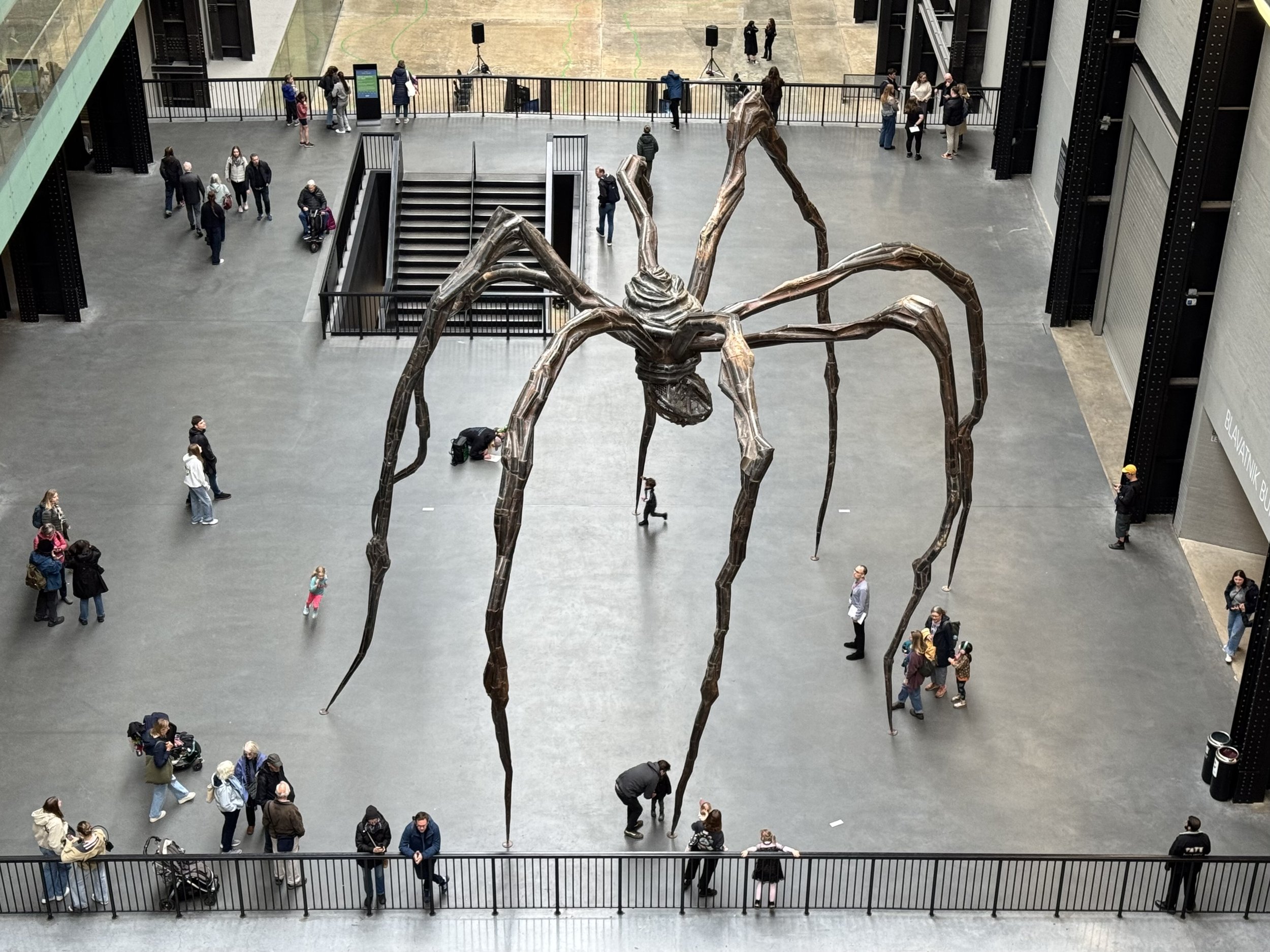Maman (1999)
Louise Bourgeois (1911-2010)
Maman (1999)
Steel and marble
9.3m x 8.9m x 10.2m
Tate Modern (& various locations)
I’m not afraid to admit that I’m scared of spiders. Not the teeny tiny house ones. I don’t really mind those. It’s the ones that have a leg-span greater than the diameter of a 10p coin that start to freak me out. And if those legs get thick and furry enough to look like a pipe cleaner? That’s when I shriek like a Freddy Krueger victim. Oddly, however, there is one notable exception, and it’s one of the largest spiders in the world.
I first encountered Louise Bourgeois’s Maman in Bilbao. I assumed the name was a Spanish title (I was always crap with languages) but like the artist it’s French, for Mummy, the casual word for Mother. That title, combined with the natural ability for a spider to spin silk, are frequently cited as references to both the close relationship the artist had with her mother, and her family’s tapestry business.
Spiders have played a role in Bourgeois’s art throughout her career. They are both predator and protector, and provide an appropriately complex motif for an artist that spent a lifetime creating works that often addressed the many family traumas she faced: her brother was institutionalised, her father openly carried out multiple affairs and her mother died young. But it wasn’t until her late 80s that the motif would take centre stage in Bourgeois’s work. She was commissioned as the inaugural artist to place an installation in London’s brand new Tate Modern museum. Maman was the result.
There’s something about radical shifts in scale that fundamentally change emotion as well as perspective. Maman is ten metres tall. Standing beneath it you don’t just look up to see the body of the spider; you have to crane your neck so far back that it hurts, and you risk toppling onto your bum. It should be the scariest thing in the world to stand underneath a spider that big but I’ve yet to see anyone, anywhere, of any age, utter anything other than amazement. I suspect there’s some subconscious soothing of the mind from the fact that the eight spindly legs are all securely bolted to the floor.
I’ve witnessed jaws drop, eyes go wide, and children chase each other around the beast like it’s a Maypole. The work is so popular that multiple bronze casts have been made (the original is steel) which both tour and have permanent placements around the world. Argentina, Canada, Cuba, France, Greece, Japan, Mexico, Russia, South Korea, Spain, Thailand and the United States are just a dozen of the stamps Maman has collected in it’s passport. It’s reach is almost as wide as the British Empire, and stumbling upon it while on holiday or a business trip presents the same comforting joy as randomly spotting a familiar face in a foreign place.
Regional Maman & other Bourgeois spiders
For the Tate Modern’s 25th anniversary the steel original is back inside the Turbine Hall. Having seen Maman in many other locations I can personally confirm that there’s no place like home. Actually, it’s better because you can now admire this amazing beautiful monster from four distinct vantage points thanks to the museum’s extension in 2016. Straddling the gangplank in the centre of the Turbine Hall you can walk directly underneath it or look up at it from the lower level below. You can view it from side-on as you sit in the comfortable 2nd floor leather sofas that are eye-level with the body and egg sac, or you can stare down at it from the 4th floor bridge.
To date, two dozen artistic interventions have attempted to radically transform the Turbine Hall. Some have become landmark moments in art. Too many others have been less than impactful despite filling the space with as much material as possible. Maman is tall, slender and thin, with legs that visually blend in with the surrounding steel girders, so it’s easy to miss it and assume the hall is empty. Until you see it. Standing still, silently commanding every attendee to stop and stare and admire it’s powerful presence.
Maman might just be the most perfect Turbine Hall artwork (1). Not just because of how perfectly it transforms the venue, but also as a metaphor for me. I arrived in London shortly after Maman’s inaugural run ended, but that didn’t stop the Tate Modern from becoming the place, outside of my flat, where I have spent the most amount of my free time over the past twenty five years. I’ve been stuck in the Tate Modern’s web for almost its entire existence, and it’s a joy and an honour to finally be able to see the inaugural Turbine Hall commission (2) in the venue where it all began.
That’s why I like it.
There’s no place like home.
Previously, on Why I Like It:
Apr — Grapnel (2023), William Cobbing
Mar — Rhino Costume (1989), Gerald Scarfe
Feb — I Want My Time With You (2017), Tracey Emin
Footnotes
OK, I concede. It’s the second best. Olafur Eliasson’s The Weather Project will always be the best, and I know because I attended that one multiple times.
Technically, Maman was only one of many elements that Louise Bourgeois made for the inaugural commission (I Do, I Undo, and I Redo) except no one has seen or even mentioned the other pieces since.




















